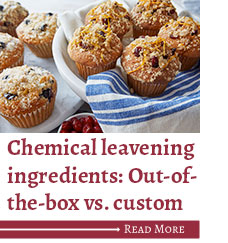With process and product qualities in mind, formulators dealing with a tailored chemical leavening system must balance their formulation correctly.
“You can’t just throw one pound of baking soda in and add one pound of one of the leavening acids,” said Nita Livvix, senior food scientist and technical support, Clabber Girl. “Formulators have to know about neutralizing values and how to calculate those amounts to make sure their formulas are balanced.”
Without a balanced formula, she warned, the finished product just won’t be of optimal quality.
Each leavening acid has a different neutralizing value and gas release rate that determines the amount needed to counterbalance the gas source. The acidic ingredients must neutralize the sodium bicarbonate so that the final product contains no lingering residue of any of the leavening agents. Determining this amount requires knowledge of product, process and math.
For example, monocalcium phosphate monohydrate (MCP) has a neutralizing value of 80.
“To determine the amount needed, a formulator must first decide how much of the gas reaction needs to take place with liquid and how much with heat,” Ms. Livvix said. “Because monocalcium phosphate releases approximately 60% of its gas release with liquid and 40% of heat, the baker must consider the type of leavening reaction needed for the product to be baked.”
Only then can the baker use a calculation to determine the amount of MCP needed.
All leavening acids, however, have different neutralizing values and gas release rates, and these determine the rate of reaction.
“For this reason, two or more leavening acids are often used together to provide the ideal gas release for a bakery product,” Ms. Livvix explained.
These ingredients also have an impact on the finished product’s pH, which will influence color, flavor and shelf life. Managing pH will result in a baked food with the baker’s desired characteristics. Too much baking soda will result in a high pH while too much acid gives a lower pH.
 “Typically, baked products with a higher pH will have darker bakes with a soapier flavor profile, while items with a lower pH feature lighter baked colors and a flavor profile with a more tart taste,” said Paul Bright, innovation manager, AB Mauri North America.
“Typically, baked products with a higher pH will have darker bakes with a soapier flavor profile, while items with a lower pH feature lighter baked colors and a flavor profile with a more tart taste,” said Paul Bright, innovation manager, AB Mauri North America.
There can be some products where a pH leaning one way or another could be desirable to the final product.
“For example, to produce a buttermilk biscuit with a white crumb color and the desired biting buttermilk flavor, the pH of the biscuit must be lower than that of a standard biscuit,” Mr. Bright said.
Balancing a formula, managing pH and getting the reaction just right may seem intimidating, but with the help of ingredient suppliers and their testing labs, bakers can find the right solutions.
“We have a comprehensive understanding of not only bakery applications and processes but also formulation and ingredient functionality,” Mr. Bright said of AB Mauri North America’s capabilities. “This understanding even reaches down to the level of individual raw materials used to produce chemical leavening or baking powder systems. We understand that although raw materials may have similar names and data sheets, they may produce different outcomes for the baker. In the end, we can develop specific, consistent leavening systems that will enable bakers to produce high-quality baked goods.”
Bakers can also take advantage of Innophos’ application lab that houses capabilities to mimic their processes and see how the various ingredients will respond back home in the bakery.
At the end of the day it’s all about having a good working relationship to meet each individual product’s unique leavening needs.
“Working with leavening suppliers to learn about product options is the best way to ensure the finest bakery products,” Ms. Livvix said.
This article is an excerpt from the February 2019 issue of Baking & Snack. To read the entire feature on chemical leavening, click here.




